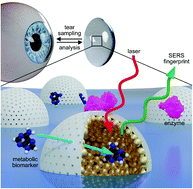SERS optical accumulators as unified nanoplatforms for tear sampling and sensing in soft contact lenses†
Abstract
Tear analysis has become an invaluable asset in clinical research in order to identify and quantify novel biomarkers for a wide array of conditions. The present work is intended to take this area of study one step further by implementing an innovative sensing platform through which exploration of low-molecular-weight compounds is conducted outperforming traditional analytical technologies. With this aim, carefully engineered plasmonic nanoassemblies have been synergistically combined with molecular-sieving materials giving rise to size-selective samplers with SERS detection capabilities. These architectures have been then integrated onto hydrogel-based contact lenses and tested in simulated tear fluids in order to evidence their operational features. Through this approach, a prolonged analyte accumulation can be realized, thus providing a competitive advantage in those scenarios where concentration of biomarkers is typically low or minimum sample volumes are not met. Additionally, quenching of metabolic flux and analyte extraction protocols can be circumvented, hence preventing the intrinsic physical and chemical interferences stemming from these procedures. The obtained results render these sensing platforms as promising medical devices, and constitute a great opportunity in order to expand the clinical toolkit in tear analysis.



 Please wait while we load your content...
Please wait while we load your content...